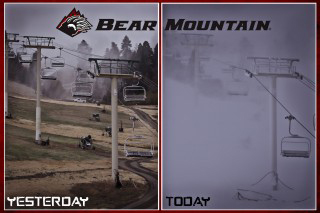
No natural snow? No problem at resorts with snowmaking capabilities, as long as temperatures dip low enough so crews can put the systems to work — like they did at Bear Mountain in early November. (Bear Mountain photos)
By Art Bentley
Although Sun Valley’s Bald Mountain offers nearly three times the vertical of our own Snow Summit, these two great ski areas ensure their success with the same winning formula.
The fortunes of Sun Valley are linked as inextricably as those of the 60-year-old resort at Big Bear Lake to a prodigious capacity for turning water and compressed air into a four-letter word of supreme importance to that segment of the populace transported to ecstasy by its “plentitude” or driven to madness by its lack thereof.
That word is “snow.”
In its manufactured form, it allowed resorts as different yet similar as Sun Valley in Idaho and Snow Summit and its neighbor, Bear Mountain, which it owns, to succeed last season, while most other ski areas that depend far more heavily on nature for their snow struggled mightily.
Except in Southern California, big snowstorms seem a lock in the ski country of the West from late November until mid-April or so. Last winter, however, there was no significant snow anywhere in the Western U.S. until well past New Year’s Day. Many resorts missed the Christmas holidays, a huge financial blow.
But at Sun Valley and the two Big Bear Lake resorts, it was business as usual.
At Sun Valley, as at Big Bear Lake, they really don’t care whether it snows. All they want are cold, dry temperatures — and there were many last December and January. At that time, when the runs of competitors were covered with dirt, skiing the 3,400 vertical feet top to bottom on Bald Mountain was excellent.
In 1991, owner Earl Holding, who had acquired the resort in 1977, spent $15 million to install what was then North America’s largest automated snowmaking system. Since then, Sun Valley has invested in new, more energy-efficient equipment and has expanded the system so that today, 80 percent of the designated runs are lined with 555 giraffe-like guns that blow clouds of snow up to 50 feet high.
When they’re firing, each gun is controlled by a central computer that gets a data feed every seven to eight minutes and makes calculations and adjustments on the fly. The data comes from weather stations that look like bird cages, one for every five to 10 guns.
Operators calculate the moisture content of the air and tell the computer what they want in terms of snow characteristics.
The computer passes the electronic word to the guns, but the guns also appear to have minds of their own. If the weather stations detect a drop in temperature, the guns will request more water.
“Back in the ’70s it was obvious that snowmaking was essential,” said Jack Sibbach, marketing director. “But it was Mr. Holding who made the commitment. He knew it was an essential investment we would have to make for our future. Some years we might not need it as much as others, but there are going to be years we’re going to need it a lot to get the quality of product we want and our guests deserve.”
Last winter was one of the times when Sun Valley needed snowmaking a lot — not only the resort but also the nearby businesses that depend on the resort’s success for their own good fortunes.
“Last year at Christmas, snowmaking saved the community,” Sibbach said. “It was a huge economic boon and we had a great Christmas.”
Despite a lack of natural snow, the entire community did well — lodging, retail and restaurants. That was a testament to Mr. Holding and his investment and the guys who do all the hard work, the snowmakers and groomers.
That’s the kind of Christmas story that would warm the heart of the equally savvy Dick Kun, who operates Snow Summit and Bear Mountain and who believes just as strongly in the power of snowmaking to change the ski world. Neither Sun Valley nor his Big Bear Lake resorts would be competitive without it.
Art Bentley can be reached via email, at hobacks@aol.com.
